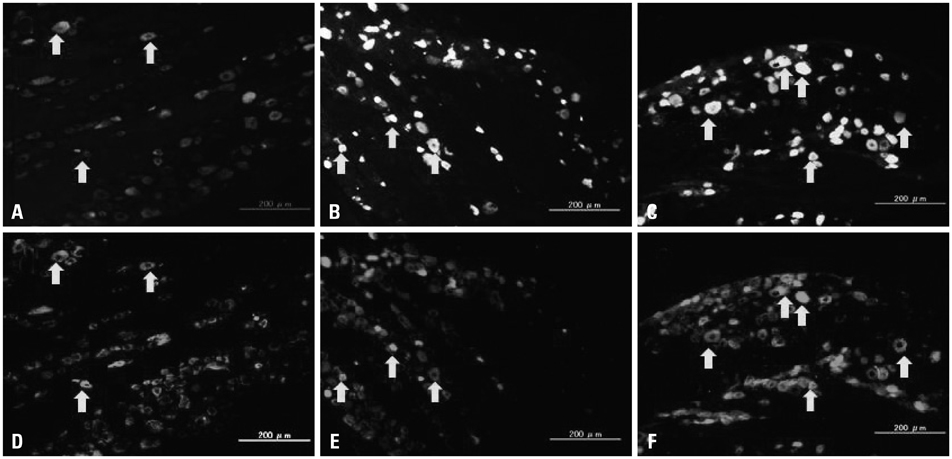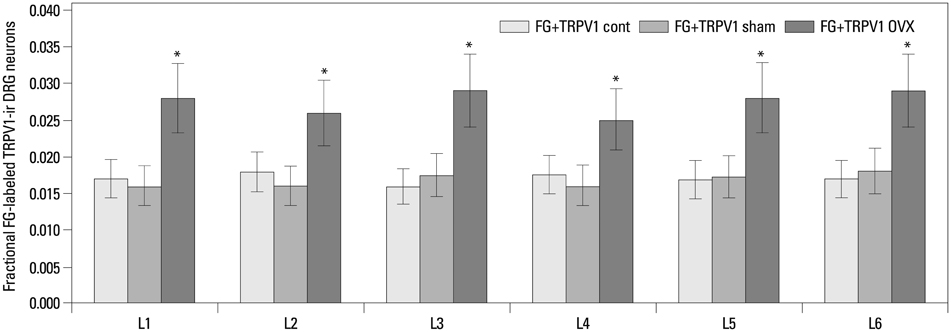Yonsei Med J.
2014 Nov;55(6):1600-1605. 10.3349/ymj.2014.55.6.1600.
Increase of TRPV1-Immunoreactivity in Dorsal Root Ganglia Neurons Innervating the Femur in a Rat Model of Osteoporosis
- Affiliations
-
- 1Department of Orthopaedic Surgery, Graduate School of Medicine, Chiba University, Chiba, Japan. sohtori@faculty.chiba-u.jp
- KMID: 2070208
- DOI: http://doi.org/10.3349/ymj.2014.55.6.1600
Abstract
- PURPOSE
Transient receptor potential vanilloid 1 (TRPV1) is a ligand-gated nonselective cation channel, which can be activated by capsaicin and other noxious stimuli. Recently, an association between bone pain and TRPV1 has been reported. However, the influence of osteoporosis on TRPV1 in the sensory system innervating the femur has not been reported.
MATERIALS AND METHODS
TRPV1-immunoreactive (ir) in dorsal root ganglia (DRG) neurons labeled with neurotracer [Fluoro-Gold (FG)] innervating the femurs of Sprague Dawley rats were examined in control, sham, and ovariectomized (OVX) rats. We evaluated osteoporosis in the femurs and compared the proportion of TRPV1-ir DRG neurons innervating femur between the 3 groups of rats.
RESULTS
OVX rats showed osteoporotic cancellous bone in the femur. FG labeled neurons were distributed from L1 to L6 DRG, but there was no significant difference in the proportion of labeled neurons between the 3 groups (p>0.05). The proportions of FG labeled TRPV1-ir DRG neurons were 1.7%, 1.7%, and 2.8% of DRG neurons innervating the femur, in control, sham-operated, and OVX rats, respectively. The proportion of TRPV1-ir neurons in DRG innervating the femur in OVX rats was significantly higher than that in control and sham-operated rats (p<0.05).
CONCLUSION
Under physiological conditions, DRG neurons innervating femurs in rats contain TRPV1. Osteoporosis increases the numbers of TRPV1-ir neurons in DRG innervating osteoporotic femurs in rats. These findings suggest that TRPV1 may have a role in sensory perception of osteoporotic femurs.
MeSH Terms
Figure
Reference
-
1. Ralston SH, Layfield R. Pathogenesis of Paget disease of bone. Calcif Tissue Int. 2012; 91:97–113.
Article2. Mach DB, Rogers SD, Sabino MC, Luger NM, Schwei MJ, Pomonis JD, et al. Origins of skeletal pain: sensory and sympathetic innervation of the mouse femur. Neuroscience. 2002; 113:155–166.
Article3. Mantyh WG, Jimenez-Andrade JM, Stake JI, Bloom AP, Kaczmarska MJ, Taylor RN, et al. Blockade of nerve sprouting and neuroma formation markedly attenuates the development of late stage cancer pain. Neuroscience. 2010; 171:588–598.
Article4. Freeman KT, Koewler NJ, Jimenez-Andrade JM, Buus RJ, Herrera MB, Martin CD, et al. A fracture pain model in the rat: adaptation of a closed femur fracture model to study skeletal pain. Anesthesiology. 2008; 108:473–483.5. Yang CJ, Wang XW, Li X, Wu GC, Wang YQ, Mao-Ying QL. A rat model of bone inflammation-induced pain by intra-tibial complete Freund's adjuvant injection. Neurosci Lett. 2011; 490:175–179.
Article6. Jimenez-Andrade JM, Mantyh WG, Bloom AP, Freeman KT, Ghilardi JR, Kuskowski MA, et al. The effect of aging on the density of the sensory nerve fiber innervation of bone and acute skeletal pain. Neurobiol Aging. 2012; 33:921–932.
Article7. Tominaga M, Caterina MJ, Malmberg AB, Rosen TA, Gilbert H, Skinner K, et al. The cloned capsaicin receptor integrates multiple pain-producing stimuli. Neuron. 1998; 21:531–543.
Article8. Guo A, Vulchanova L, Wang J, Li X, Elde R. Immunocytochemical localization of the vanilloid receptor 1 (VR1): relationship to neuropeptides, the P2X3 purinoceptor and IB4 binding sites. Eur J Neurosci. 1999; 11:946–958.
Article9. Yu L, Yang F, Luo H, Liu FY, Han JS, Xing GG, et al. The role of TRPV1 in different subtypes of dorsal root ganglion neurons in rat chronic inflammatory nociception induced by complete Freund's adjuvant. Mol Pain. 2008; 4:61.
Article10. Niiyama Y, Kawamata T, Yamamoto J, Omote K, Namiki A. Bone cancer increases transient receptor potential vanilloid subfamily 1 expression within distinct subpopulations of dorsal root ganglion neurons. Neuroscience. 2007; 148:560–572.
Article11. Niiyama Y, Kawamata T, Yamamoto J, Furuse S, Namiki A. SB366791, a TRPV1 antagonist, potentiates analgesic effects of systemic morphine in a murine model of bone cancer pain. Br J Anaesth. 2009; 102:251–258.
Article12. Iwamoto J, Takeda T, Ichimura S, Matsu K, Uzawa M. Effects of cyclical etidronate with alfacalcidol on lumbar bone mineral density, bone resorption, and back pain in postmenopausal women with osteoporosis. J Orthop Sci. 2003; 8:532–537.
Article13. Ohtori S, Akazawa T, Murata Y, Kinoshita T, Yamashita M, Nakagawa K, et al. Risedronate decreases bone resorption and improves low back pain in postmenopausal osteoporosis patients without vertebral fractures. J Clin Neurosci. 2010; 17:209–213.
Article14. Brown MF, Hukkanen MV, McCarthy ID, Redfern DR, Batten JJ, Crock HV, et al. Sensory and sympathetic innervation of the vertebral endplate in patients with degenerative disc disease. J Bone Joint Surg Br. 1997; 79:147–153.
Article15. Orita S, Ohtori S, Koshi T, Yamashita M, Yamauchi K, Inoue G, et al. The effects of risedronate and exercise on osteoporotic lumbar rat vertebrae and their sensory innervation. Spine (Phila Pa 1976). 2010; 35:1974–1982.
Article16. Luo D, Zhang YW, Peng WJ, Peng J, Chen QQ, Li D, et al. Transient receptor potential vanilloid 1-mediated expression and secretion of endothelial cell-derived calcitonin gene-related peptide. Regul Pept. 2008; 150:66–72.
Article17. Bonabello A, Galmozzi MR, Bruzzese T, Zara GP. Analgesic effect of bisphosphonates in mice. Pain. 2001; 91:269–275.
Article18. Fulfaro F, Casuccio A, Ticozzi C, Ripamonti C. The role of bisphosphonates in the treatment of painful metastatic bone disease: a review of phase III trials. Pain. 1998; 78:157–169.
Article19. Van Offel JF, Schuerwegh AJ, Bridts CH, Bracke PG, Stevens WJ, De Clerck LS. Influence of cyclic intravenous pamidronate on proinflammatory monocytic cytokine profiles and bone density in rheumatoid arthritis treated with low dose prednisolone and methotrexate. Clin Exp Rheumatol. 2001; 19:13–20.20. Varenna M, Zucchi F, Ghiringhelli D, Binelli L, Bevilacqua M, Bettica P, et al. Intravenous clodronate in the treatment of reflex sympathetic dystrophy syndrome. A randomized, double blind, placebo controlled study. J Rheumatol. 2000; 27:1477–1483.21. Constantin CE, Mair N, Sailer CA, Andratsch M, Xu ZZ, Blumer MJ, et al. Endogenous tumor necrosis factor alpha (TNFalpha) requires TNF receptor type 2 to generate heat hyperalgesia in a mouse cancer model. J Neurosci. 2008; 28:5072–5081.
Article22. Kochukov MY, McNearney TA, Yin H, Zhang L, Ma F, Ponomareva L, et al. Tumor necrosis factor-alpha (TNF-alpha) enhances functional thermal and chemical responses of TRP cation channels in human synoviocytes. Mol Pain. 2009; 5:49.23. Liu J, Liu X, Duan K, Zhang Y, Guo SW. The expression and functionality of transient receptor potential vanilloid 1 in ovarian endometriomas. Reprod Sci. 2012; 19:1110–1124.
Article24. Suzuki M, Orita S, Miyagi M, Ishikawa T, Kamoda H, Eguchi Y, et al. Vertebral compression exacerbates osteoporotic pain in an ovariectomy-induced osteoporosis rat model. Spine (Phila Pa 1976). 2013; 38:2085–2091.
Article
- Full Text Links
- Actions
-
Cited
- CITED
-
- Close
- Share
- Similar articles
-
- Transient Receptor Potential Vanilloid 1-Immunoreactive Innervation Increases in Fractured Rat Femur
- Neurochemical Characterization of the TRPV1-Positive Nociceptive Primary Afferents Innervating Skeletal Muscles in the Rats
- Capsaicin Blocks the Hyperpolarization-Activated Inward Currents via TRPV1 in the Rat Dorsal Root Ganglion Neurons
- Effects of capsaicin on the c-fos Protein-like immunoreactivities in the spinal cord and substance P- and CGRP-like immunoreactivities in the dorsal root ganglia of the experimental arthritic rat model
- The Distribution of CGRP Containing Cells Innervating the Calcaneal Tendon in Rat Dorsal Root Ganglia





